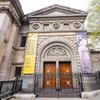More about Louise de Kéroualle, Duchess of Portsmouth with an unknown female attendant

Sr. Contributor
Pierre Mignard paints Louise de Kerouaille, Mistress of Charles II, to send one clear message: “I’m beautiful and dirty rich.”
Louise was sent to England by Louis XIV, essentially on a mission to seduce King Charles and spy for France. Louise caught Charles’ eye, and was made lady in waiting to his wife, Queen Catherine. Charles was a fan of the Jude Law strategy of employing women in your wife’s household for easy access.
Charles II’s Whitehall Palace was the Playboy Mansion of the 17th century…corsets optional in the grotto. He had dozens of gorgeous women on hand for his amusement, but these were no bimbos. She who had the key to the royal bedchamber had the keys to the kingdom, and courtesans were the most powerful women in Europe. They were also the tabloid divas of their day. The commoners loved them and loved to hate them, circulating pamphlets depicting their beauty, outrageous fashions, public catfights, and often pornography of their sexual exploits. Louise was despised because she was a foreigner and a Catholic, and had a reputation for sleeping around on the King.
Her chief rival was Charles’ other favorite flavor Nell Gwyn, a beloved sex symbol from the London Stage whose favorite hobby (at least when she was standing up) was making Louise’s life hell. Nell nicknamed Louise “Squintabella” for her disagreeable expression, and “Weeping Willow” for her tendency to cry to get what she wanted. She gleefully gossiped about Louise’s dirty underwear. When Nell was mobbed in the street by a crowd who mistook her for Louise, calling her a Catholic whore, Nell retorted, “Good people…you are mistaken; I am the Protestant whore.” Oh no she di’int!
Louise loved money, and loved to spend it. Her 40-room “apartment” at Whitehall was redecorated three times to keep up with the fashion, and was said to be grander than the Queen’s…snap! Mignard painted her just as she wanted to be seen, in a fabulous gown, drowning in luxury accessories.
One accessory is particularly conspicuous here: an attractive black child decked out in expensive duds, offering exotic treasures to Louise. In the 17th century, enslaved children were imported from Africa or the West Indies to be sold as playthings for wealthy women. The ladies dressed them up like little dolls, and had them follow them around like puppies to show off to the court or play with when bored. They were a must-have fashion item, showing wealth and status better than any jewel could, and also making the white woman’s complexion look fairer by contrast. If you think these “toy” slaves won the slavery lottery, think again. When they outgrew their cuteness they were deported to the Caribbean where they were typically worked to death on sugar plantations.















